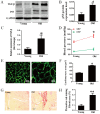Age‑related changes in mineralocorticoid receptors in rat hearts
- PMID: 32582979
- PMCID: PMC7411371
- DOI: 10.3892/mmr.2020.11260
Age‑related changes in mineralocorticoid receptors in rat hearts
Abstract
Age-related alterations in the renin-angiotensin-aldosterone system (RAAS) have been reported in the cardiovascular system; however, the detailed mechanism of the RAAS component mineralocorticoid receptors (MR) has not been elucidated. The present study aimed to investigate the associations between MR and cardiac aging in rats, as well as the regulatory effects of oxidative stress and mitochondrial abnormalities in the aging process. MR expression in the hearts of male Sprague‑Dawley rats aged 3 months (young rats) and 24 months (old rats) was evaluated in vivo. In addition, in vitro, H9C2 cells were treated with a specific MR antagonist, eplerenone, in order to investigate the molecular mechanism underlying the inhibition of myocyte aging process. The results demonstrated that MR expression was significantly higher in 24‑month‑old rat hearts compared with in 3‑month‑old rat hearts. These changes were accompanied by increased p53 expression, decreased peroxisome proliferator‑activated receptor γ coactivator‑1α expression, decreased mitochondrial renewal as assessed by electron microscopy, increased oxidative stress and decreased superoxide dismutase. In vitro, selective antagonism of MR partially blocked H2O2‑induced myocardial aging as assessed by p16, p21 and p53 expression levels and excessive reactive oxygen species (ROS) accumulation. These results indicated that increased MR expression may drive age‑related cardiac dysfunction via mitochondrial damage, increased ROS accumulation and an imbalanced redox state.
Keywords: mineralocorticoid receptors; cardiac aging; oxidative stress; mitochondrial dysfunction; redox state.
Figures





References
-
- United Nations, Department of Economic, Social Affairs, Population Division. World Population Ageing 2017 - Highlights (ST/ESA/SER.A/397). United Nations, New York, NY, 2017. https://www.un.org/en/development/desa/population/publications/pdf/agein...
-
- Rickard AJ, Morgan J, Bienvenu LA, Fletcher EK, Cranston GA, Shen JZ, Reichelt ME, Delbridge LM, Young MJ. Cardiomyocyte mineralocorticoid receptors are essential for deoxycorticosterone/salt-mediated inflammation and cardiac fibrosis. Hypertension. 2012;60:1443–1450. doi: 10.1161/HYPERTENSIONAHA.112.203158. - DOI - PubMed
MeSH terms
Substances
LinkOut - more resources
Full Text Sources
Medical
Molecular Biology Databases
Research Materials
Miscellaneous

